
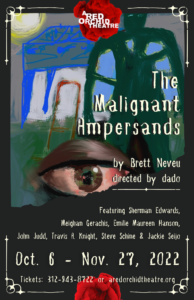 [rating=2]“The Malignant Ampersands”, written by ensemble member Brett Neveu and directed by dado, is a morbid tale about a family with more than its share of disease, decline, and death. This world premiere production, appropriate for the Halloween season, is full of dark underpinnings that are a nod to human suffering. The premise of the story is that whether you are destined to be healthy or ill or whether your family is cursed or not, it’s all in the DNA, which you have no control over. Yet the main character Gabe (Travis A. Knight) is destined to be the Ampersand family’s savior, or so it is said at several points during the show. The production is supposed to be a “very unofficial sequel to Orson Welles’ 1942 movie “The Magnificent Ampersands”, which by all accounts was a nightmare and a disastrous flop. According to “The Guardian”, the original movie is “regarded as one of the great travesties in film history.” The apple doesn’t fall far from the tree.
[rating=2]“The Malignant Ampersands”, written by ensemble member Brett Neveu and directed by dado, is a morbid tale about a family with more than its share of disease, decline, and death. This world premiere production, appropriate for the Halloween season, is full of dark underpinnings that are a nod to human suffering. The premise of the story is that whether you are destined to be healthy or ill or whether your family is cursed or not, it’s all in the DNA, which you have no control over. Yet the main character Gabe (Travis A. Knight) is destined to be the Ampersand family’s savior, or so it is said at several points during the show. The production is supposed to be a “very unofficial sequel to Orson Welles’ 1942 movie “The Magnificent Ampersands”, which by all accounts was a nightmare and a disastrous flop. According to “The Guardian”, the original movie is “regarded as one of the great travesties in film history.” The apple doesn’t fall far from the tree.
For over the last one hundred years, there has been a curse on the Ampersand family. While the audience doesn’t see their actual decline over time, we do witness the deterioration of the family’s remaining six members, each of whom appear to be sick or dying or have some physical or mental ailment. While Gabe tries to hide his illness, the other family members are more open about their health issues, including his third cousin “not removed” Corey (Steve Schine); the always optimistic Summer (Emilie Maureen Hanson); the morbidly ill Hiker (Meghan Gerachs), who suffers from osteosarcosis (possibly osteosarcoma) and who has had both of her hands amputated; the aged West (John Judd), who has severe medical problems and cannot walk without support, and the nearly deceased Jamie (Sherman Edwards), who lies supremely ill in his hospital bed with open sores on his face and body. Then there is a type of mystic refrain throughout, when the characters talk of going “through the crypt and the dirt to go into the sun.” Hanson has a gorgeous singing voice and twice sings this stirring song about soul travel. This is one of the best parts of the show!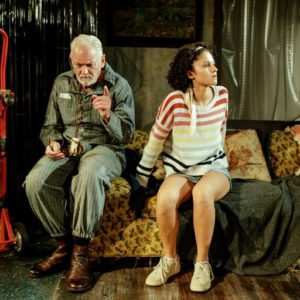
Fifteen minutes into the performance, however, I decided that the story was much too disjointed, with lots of meaningless dialogue, and I wasn’t clear where the plot was heading or why. The inclusion of a good bit of local color and corporate names did not make up for this deficiency. Except for the occasional piques of insight and the occasional “scare” by the shadow figure, the show was much too ho-hum for the most part—and it shouldn’t be this way! The fact that Hiker has no hands makes this story a horror tale from the get-go, but the presentation as a whole ought to stir up the audience’s baser instincts and create conflict within us about the moral choices that the various characters have to make. To put it bluntly, the story doesn’t stir up enough emotion when it should have, and there are too many moments when we are too far removed from the characters to care what might happen to them.
That said, character development is interesting when it does occur: for example, in the characters of Hiker and West, whose illnesses have affected not only their physical wellbeing but their reasoning process. Yet I felt I needed to feel more for Gabe, since he is at the center of the tale. With his seeming interests in foosball, food, and alcohol, his character is much too shallow and amorphous to be appealing (although someone 18 to 25 years old might disagree with me). Gabe needs to be a deeper person from the get-go, so as to increase the dramatic tension when faced with a disconcerting moral dilemma. We also need to learn more about Corey from the onset, so we can better understand the family dynamics and why he is the one who makes sure that everybody is kept in the best health possible and gets their medicines. We also need more intellectual and ethical fortitude from Corey as a counterpoint to the opinions of the other characters. Then, on the directing side, the device of a telephone is used much too frequently and places the actors too far away from each other physically and in terms of making their arguments to each other. This distancing also serves to separate the audience from the characters. Rather than using a telephone, the actors ought to be on stage at the same time to discuss the moral, ethical, and rational reasons for taking action or not.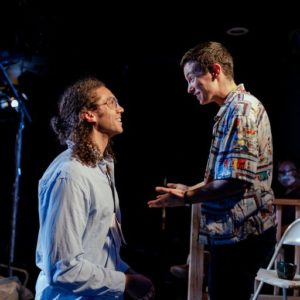
There is a moment, not too far from the end, when the course of the tale becomes clearer and things start to make sense. Although a number of loose threads get tied up then, the ending is not entirely successful. For example, we never fully understand why Summer seems to straddle more than one universe or the space between light and shadow—or why the shadow figure follows some characters but not others and why some characters are healed and others are not. It also isn’t clear whether a character has sacrificed their soul or whether we are dealing with a case of demon possession or karma.
The least interesting scene has to do with the time that West is in the hospital and Summer and Gabe alternatively sit in Starbucks rather than in the hospital waiting room. This is when we meet Bobbie (Jackie Seijo), who works as a Starbucks barista. The conversational back-and-forth unfortunately does not add to the tale, except to know that there are some young people who like to throw unknown pills into their alcoholic beverages and consume them for whatever effect they might have on the body. The only reason I could imagine for this portion of the show is that it creates a sharp contrast to those characters who are serious about their medications and take pills to fight or prevent disease. (And if I were Burger King or Starbucks—both mentioned in this script—I’d be suing right now, but I digress.)
Even though horror is not my type of genre, one of the best parts of this production is watching the shadow person make its appearance throughout. This is a giant life-sized puppet, nice and scary, that often seems to follow or replace the character of Summer. Kudos to puppet designer Lolly Extract/Jabberwocky Marionettes. Mike Durst’s lighting design is creative but uneven, with too much use of strobe lighting at the very beginning, although I liked the deep red lights which accentuate the horror between scenes. Scenic designer Grant Sabin has created a fairly vanilla set that provides a good canvas for the props by Eren Ahn. Costumes by Myron Elliott-Cisneros are good and are pretty much what one would expect for a story that takes place right now.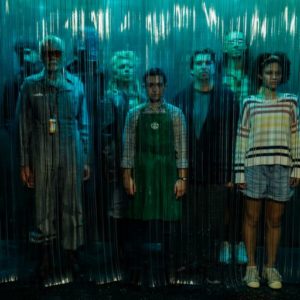
For better or worse, “The Malignant Amperands” has largely strayed from most aspects of the original novel written by Booth Tarkington and filmed by Orson Welles. The original movie was about a family in the Midwest, and the current play is set in Chicago, so there’s a loose connection here. At the very least, changing “magnificent” to “malignant” is clever, considering how decrepit each of the characters are or have become. Also clever is changing the last name “Amberson” to “Ampersand.” There are also some weird but memorable lines throughout, such as “You can pick your nose, but you can’t pick your family.” When all is said and done, you don’t have to pick this show either.
For those of you looking for an uplifting presentation or one with a basis in rationality, this is not the play I’d recommend. But if you like dark and dreadful stories (and I mean dark and dreadful in the best of all possible ways), then this performance might work for you. Although it is 100 minutes with no intermission, it seems a lot longer. After the show ended, the man sitting next to me said, “I’m looking forward to seeing your review, so you can tell me what it was all about.”
“The Malignant Ampersands” runs through November 27, 2022, at A Red Orchid Theatre, 1531 N. Wells, in Chicago.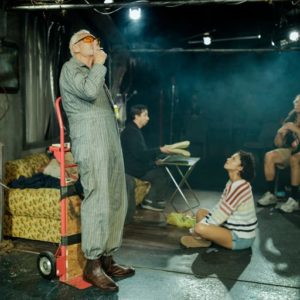
Tickets are $30 for Thursdays; $35 for Friday and Saturday matinee; and $40 for Saturday evening and Sunday matinee.
Performance schedule:
Thursdays and Fridays – 7:30 p.m.
Saturdays – 3:00 p.m. and 7:30 p.m.
Sundays – 3:00 p.m.
For more information or to purchase tickets, go to https://aredorchidtheatre.org/shows/malignant-ampersands/ or phone 312-943-8722 or visit the box office at 1531 N. Wells Street, Chicago.
For more information about A Red Orchid Theatre’s current season, see:
COVID-19 protocols can change at any time. Right now, you are required to wear a mask indoors at all times and show proof of vaccination.
To see what others are saying, visit www.theatreinchicago.com, go to Review Round-Up and click at “The Malignant Ampersands.






More Stories
“Dead Man’s Cell Phone”
“the distrikt of lake michigun”
“Mother Courage and Her Children” reviewed by Jacob Davis